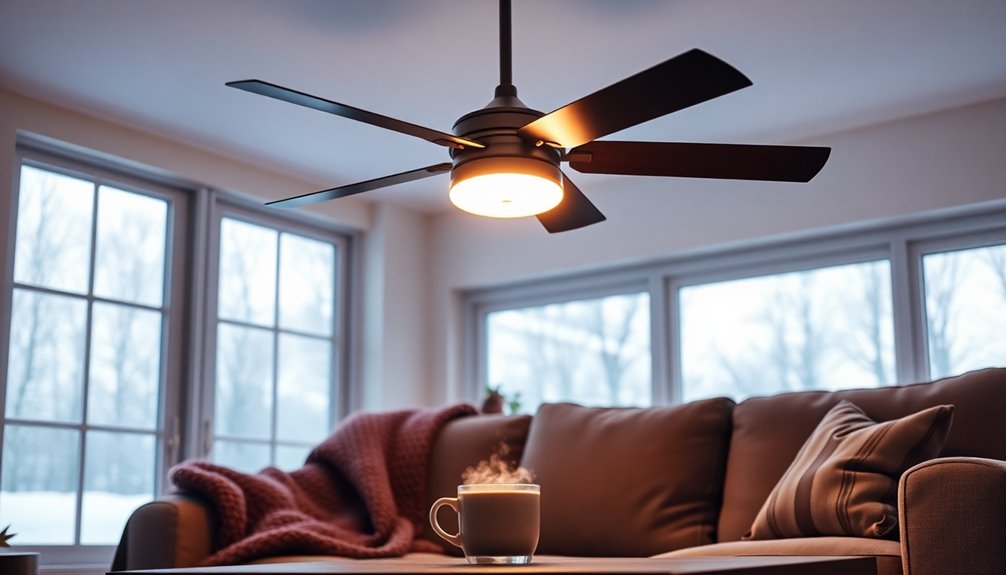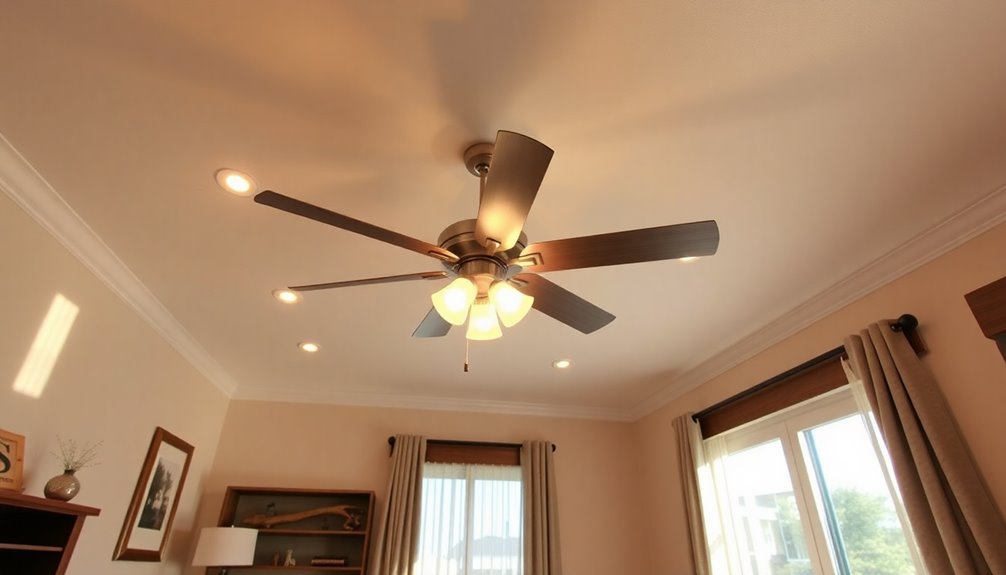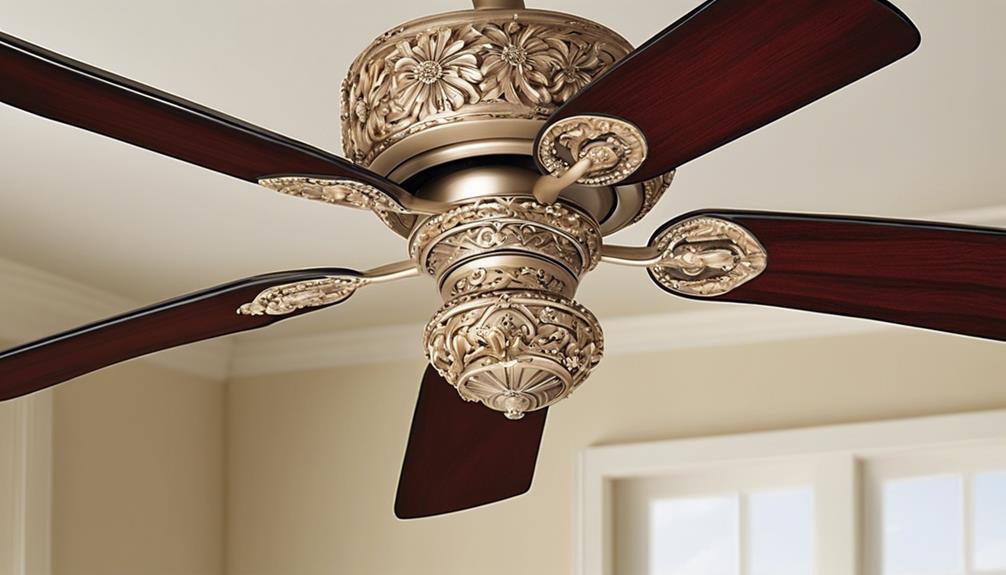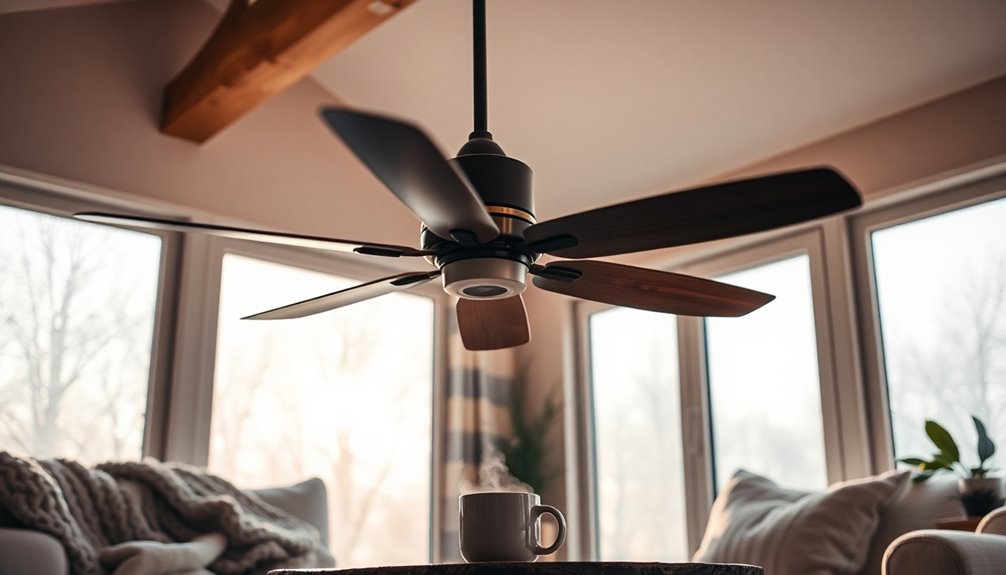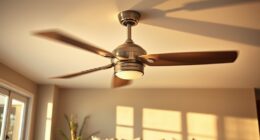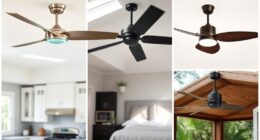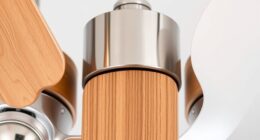In winter, you should set your ceiling fan to spin clockwise. This direction creates an updraft that pulls cool air up and pushes warm air down, keeping your space cozy and comfortable. Running the fan at a low speed is best, as it redistributes warm air effectively without causing cold drafts. This simple adjustment can help lower your heating costs by up to 15%, so it's worth checking your fan settings regularly. If you want to optimize comfort further, there are easy methods for adjusting your fan, which you'll find quite interesting!
Key Takeaways
- Set your ceiling fan to spin clockwise in winter to create an updraft and push warm air down.
- Run the fan at a low speed for effective warm air redistribution and to maintain comfort.
- Regularly check and adjust the fan direction during seasonal changes for optimal energy efficiency.
- Changing the fan direction can reduce heating costs by up to 15%, improving overall comfort.
- Use pull chains, switches, or smart apps to adjust the fan direction safely and easily.
Importance of Ceiling Fan Direction

The importance of your ceiling fan's direction during winter can't be overstated. To enhance your home's heating, your ceiling fan should spin clockwise. This rotation creates an updraft that pulls cold air upwards while pushing warm air trapped near the ceiling down toward the floor.
By redistributing the warm air, you enhance comfort and improve energy efficiency. When you change your ceiling fan to run clockwise at low speed, it prevents drafts and keeps the warm air where you need it most—at floor level.
This simple adjustment can lead to a reduction in heating costs by up to 15%. Especially in homes with high or vaulted ceilings, this seasonal change is essential for peak performance.
Regularly adjusting your fan direction in winter not only maintains warmth but also allows you to lower your thermostat settings, contributing to overall energy savings.
Recommended Winter Fan Settings

When winter arrives, it's crucial to set your ceiling fan for maximum efficiency. You should adjust the ceiling fan direction to clockwise. This rotation creates a gentle updraft, pulling cold air upward and pushing warm air down towards the floor, enhancing your comfort.
Running the fan at a low speed can greatly reduce your heating bills—up to 15%—by redistributing the warm air that tends to accumulate near the ceiling. Before making this change, verify the fan is turned off. Most fans have a fan switch near the base that allows you to reverse the direction easily.
By utilizing this clockwise setting, you can prevent cold drafts and maintain warmth throughout your space. You can also lower your thermostat settings without sacrificing comfort, making your home more energy efficient.
Remember to regularly check and adjust the fan direction with seasonal changes. This simple task can optimize your heating system's performance and save you money.
Methods to Change Fan Direction

Adjusting your ceiling fan direction for winter is a straightforward process that can greatly enhance your home's comfort.
To change the direction, make sure the fan is turned off for safety. If your fan has a pull chain, locate the fan switch on the body and slide it to the opposite direction, which is typically turning clockwise to circulate warm air downwards.
For remote-controlled fans, turn off the fan, then press and hold the fan button on the remote until the light blinks, indicating the direction has changed.
If you have smart fans, you can adjust the direction using the SIMPLEconnect app or via voice commands, but remember to turn off the fan first for the change to take effect.
For those with vaulted ceilings, make sure you can safely reach the fan or use a ladder to make the adjustment.
Regularly check the ceiling fan direction during seasonal changes to guarantee peak heating efficiency and comfort throughout winter.
Seasonal Timing for Adjustments

Knowing how to change your ceiling fan direction sets the stage for maximizing its efficiency. As winter approaches, it's essential to adjust your ceiling fan to rotate clockwise. This direction creates an updraft, helping to circulate warm air that naturally rises to the ceiling.
A great time to make this seasonal adjustment is during Daylight Savings Time, specifically when clocks fall back in the fall. By running your fan on a low speed in the clockwise direction, you can effectively redistribute warm air while preventing cold drafts. This simple change can greatly enhance your comfort during the heating season.
Moreover, regularly checking and adjusting your ceiling fan direction can lead to impressive utility bill reductions of 15% or more. Staying proactive about these seasonal adjustments not only boosts energy efficiency but also guarantees a cozy environment in your living space.
Don't overlook this easy yet effective strategy to optimize your heating setup. By prioritizing these adjustments, you can enjoy a warmer home and lower energy costs throughout the winter months.
Benefits of Proper Fan Use

Maximizing the benefits of proper ceiling fan use during winter can greatly enhance your comfort and energy efficiency. By adjusting the ceiling fan direction to clockwise and running it at a low speed, you facilitate a gentle updraft that redistributes warm air trapped near the ceiling.
This simple adjustment helps:
- Improve heating efficiency, guaranteeing warm air circulates evenly throughout the space
- Prevent cold drafts, creating a more stable indoor temperature
- Contribute to utility bill reductions of 15% or more
- Provide an energy-efficient alternative to traditional heating methods
Using ceiling fans in winter not only promotes comfort but also reduces energy costs. The combination of warm air mixing with cooler air guarantees that you can maintain a cozy environment while lowering your thermostat settings.
Plus, ceiling fans consume considerably less energy—only 15 to 90 watts—compared to conventional heating systems. By incorporating proper fan use into your winter routine, you can enjoy increased comfort, save money, and make your home more energy-efficient.
Frequently Asked Questions
Which Direction Should a Ceiling Fan Go in Winter?
When you're wondering which direction a ceiling fan should go in winter, it's important to set it to rotate clockwise.
This adjustment creates an updraft, pulling the cold air upward and pushing the warm air down towards you. By running the fan at a low speed in this direction, you can enhance comfort and potentially lower your heating bills.
Just stand underneath to check if the airflow is directed upwards, ensuring it's working effectively.
Does Reversing the Fan in Winter Really Help?
Yes, reversing the fan in winter really helps.
When you set your ceiling fan to rotate clockwise, it creates a gentle updraft that pushes warm air down from the ceiling. This circulation prevents cold spots and makes your space feel cozier.
Plus, running it at a low speed can cut your heating costs by allowing you to lower your thermostat.
You'll enjoy a more comfortable home while saving money on energy bills.
Do Ceiling Fans Really Help in Winter?
Imagine a warm hug wrapping around you on a chilly day. That's what ceiling fans can do in winter!
They really help by circulating warm air that rises to the ceiling, creating an even temperature throughout your space. By running your fan at a low speed in a clockwise direction, you can enjoy comfort while cutting down on heating costs.
Which Way Should a Ceiling Fan Turn in Summer Reddit?
In summer, your ceiling fan should spin counterclockwise. This direction creates a downdraft, pushing cool air down and giving you that invigorating breeze you love.
You'll feel cooler, which lets you raise your thermostat setting without sacrificing comfort. Just stand under the fan to check—it should blow air down towards you.
Conclusion
In winter, reversing your ceiling fan's direction can save you up to 15% on heating costs, making it a simple yet effective way to stay cozy without breaking the bank. By running your fan clockwise at a low speed, you can circulate warm air that rises, keeping your space comfortable. So, don't overlook this easy adjustment—it's a small change that can lead to big savings and a cozier home during those chilly months!
